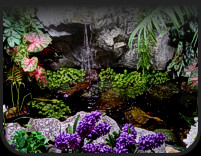 

Hundreds of backwater streams zigzag along the west coast of Africa and eventually empty into the huge Zaire (Congo) River. These backwater stream environments fluctuate depending upon the rainy and dry seasons. During the dry season, these streams evaporate. During the rainy season, they swell and overflow their banks. This flooding covers the dense tropical vegetation and creates very acidic, tea colored water environment similar to some South American streams. Very unusual fish such as the freshwater flying fish (African Butterfly Fish), brightly colored Annual fish (Killiefish), and the dolphin like sonar capable Elephant Nose Fish are found here. Dark, reddish-brown to dark brown gravel is recommended to stimulate the natural substrate. Driftwood, pebbles and low-light plants should also be used to recreate this niche.
Water Conditions |
Indigenous Fish Species |
Rare or Unusual Fish Species |
Indigenous Plant Species |
Temperature
72-76° F
pH Levels
6.3-6.8
Water Hardness
Very Soft, 40-100 ppm |
Congo Tetra
Gardneri Killiefish
Australae Killiefish
Panchex Killiefish
African Butterfly
Elephant Nose
Synodontias Catfish
Upside Down Catfish |
Rope Fish |
Anubias Varigated Barteri
Anubias Bateri Nana
Anubias Congensis
Anubias Roundleaf Nana
Anubias Hastifolia |
back to top
A 30 gallon aquarium is recommended to recreate this particular niche. A smaller size could be used, but with fewer fish. Fill the tank with two (2) inches of water. If an under gravel fish is being used, put the filter plate in the bottom of the tank at this time. Rinse the substrate (gravel/sand) and add it to the aquarium. Note: If you are using an under gravel filter add 1.5 to 2 pounds of gravel per gallon. If an under gravel filter is not being used then add 1 to 1.5 pounds of sand per gallon.
Once the substrate has been added, fill the tank half full of water. Next, add plants and driftwood to recreate your West Africa backwater stream environment. Refer to our diagram in this handout on how to landscape this niche. Don’t forget to protect the roots of your plants as you anchor them into the substrate. A safe method is to 'gently ball the roots into your hand and make a loose fist. Using this fist, burrow a pit in the substrate and gently unfold your hand, allowing the roots to spread out. Gently cover the roots with enough substrate to hold them down.
Finish filling the tank with water. Place the heater in the tank, but do not turn it on at this time. Allow the heater glass to acclimate to the water temperature in the aquarium for one (1) hour before plugging it in. You can camouflage the heater behind the driftwood and plants.
back to top
Equip the aquarium with a filter system. If you are using an under gravel filter, hook up the air pump or power head (water pump) to the uplift tubes. If you are using an internal filter, place it in the tank towards the back and hide the filter using plants or driftwood. If an outside filter is being used, place it on the outside back of the tank, or under the aquarium. Hide the siphon tube, which draws water from the tank to the filter, with tall plants or rocks. Put the thermometer in place, add water conditioner to the aquarium, and turn on the filtration system. After testing the pH and water hardness, necessary adjustments can be made by using proper aquarium chemicals to recreate West Africa backwater stream water conditions.
Now, place the aquarium top in position and make any adjustments (cut outs in the back) to accommodate the heater, filter and cords. Turn on the heater and light. A 10-12 hour light cycle is highly recommended. Make any final adjustments to the heater in order to stabilize a temperature between 72-76 degrees.
All newly set-up aquariums must go through a filter conditioning process in order to sustain fish life. (Please see our “New Tank Water Conditions” tip sheet.) It will take the water approximately 4-6 weeks to condition, during which time only a small number of fish can be added to the tank. Once the aquarium has been set up and running for a minimum of 24 hours, six (6) 1.5 inch fish per 10 gallons of water can be safely introduced. For this particular niche type, Gardneri Killifish, African Butterfly, and Upside Down Catfish would be good choices to start. Over the next several weeks when water quality tests of ammonia and nitrite reach zero, more fish species can be added.
back to top
Feeding the fish will vary depending upon the age of the aquarium. Early on, during the first 4-8 weeks, the fish should be fed a dime size pinch of food, once every other day. As the aquarium ages and conditions, 2-4 months of age, fish can be fed once a day. When the tank is over 4 months old, the fish can be fed several times a day, but remember to use small quantities of food at each feeding.
back to top
Partial water changes are the single most important procedure you perform on your aquarium. Remove 20% of the water every two (2) weeks. Replace it with fresh water that has been treated with a water conditioning chemical.
back to top
Clean unsightly algae using an algae pad or magnetic algae remover when necessary. Keep in mind that some algae left in the tank can be beneficial. It provides a food source for certain fish, and also creates oxygen for the aquarium environment.
back to top
|






